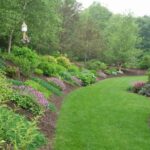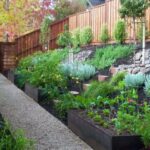Landscaping a hill can present a unique set of challenges and opportunities that differ from landscaping on flat terrain. Hills can provide a stunning backdrop for gardens, as well as opportunities for terraced gardens, scenic overlooks, and cascading water features. However, they can also be prone to erosion, limited access, and uneven terrain. With careful planning and thoughtful design, landscaping a hill can create a beautiful and functional outdoor space.
One of the first considerations when landscaping a hill is erosion control. Hills are more prone to erosion due to runoff from rainwater. To prevent erosion, it is important to plant ground cover or use retaining walls to stabilize the soil. Retaining walls can also help create terraced gardens, allowing for more planting space and adding visual interest to the landscape.
Another important aspect of landscaping a hill is assessing the drainage patterns. Proper drainage is crucial for preventing water damage and ensuring the health of plants. Consider incorporating swales, French drains, or other drainage solutions to direct water away from structures and prevent erosion on the hillside.
When designing gardens on a hill, it is important to consider the natural slope of the land and how it will affect plant growth. Plants that thrive in full sun may struggle on a steep, shaded hillside, while those that prefer moist soil may not do well on a dry, sunny slope. Choose plants that are well-suited to the conditions of the hill and group them together based on their sunlight and water requirements.
To make navigating a hilly landscape easier, consider incorporating pathways and steps into the design. Paths can create a sense of exploration and discovery, leading visitors through different parts of the garden and showcasing different views. Steps can help break up the steep slope, making it easier to access different levels of the garden and creating a sense of movement and flow.
Lastly, consider adding focal points and decorative elements to enhance the beauty of the hillside landscape. This could include a water feature, such as a pond or waterfall, a seating area with a pergola or gazebo, or a sculpture or piece of artwork. These elements can help create visual interest and draw the eye to different parts of the garden, making it a more inviting and enjoyable space to spend time in.
















